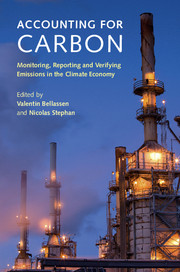Book contents
- Frontmatter
- Contents
- List of figures and map
- List of tables
- List of boxes
- Notes on contributors
- Acknowledgements
- 1 Introduction: key notions and trade-offs involved in MRVing emissions
- Part I MRV of territorial/jurisdictional emissions
- Part II MRV of industrial sites and entities
- Part III MRV at offset project scale
- 11 Trendsetter for projects: the Clean Development Mechanism
- 12 Case study 1: monitoring requirements for projects reducing N2O emissions from fertilizer use across standards
- 13 Case study 2: monitoring requirements for reforestation and improved forest management projects across standards
- 14 Case study 3: monitoring requirements for fugitive emissions from fuels in the CDM
- 15 Synthesis
- Index
- References
13 - Case study 2: monitoring requirements for reforestation and improved forest management projects across standards
from Part III - MRV at offset project scale
Published online by Cambridge University Press: 05 March 2015
- Frontmatter
- Contents
- List of figures and map
- List of tables
- List of boxes
- Notes on contributors
- Acknowledgements
- 1 Introduction: key notions and trade-offs involved in MRVing emissions
- Part I MRV of territorial/jurisdictional emissions
- Part II MRV of industrial sites and entities
- Part III MRV at offset project scale
- 11 Trendsetter for projects: the Clean Development Mechanism
- 12 Case study 1: monitoring requirements for projects reducing N2O emissions from fertilizer use across standards
- 13 Case study 2: monitoring requirements for reforestation and improved forest management projects across standards
- 14 Case study 3: monitoring requirements for fugitive emissions from fuels in the CDM
- 15 Synthesis
- Index
- References
Summary
Context
On the voluntary carbon market, 26% of all the carbon credits that were exchanged in 2012 came from forestry projects, with 9% from projects reducing emissions from deforestation and forest degradation (REDD) and 17% from reforestation and improved forest management (IFM) projects (Peters-Stanley et al., 2013). REDD projects, which take a territorial approach to MRV, are treated in a specific case study of part I variant 2 (see Chapter 4). This case study focuses on the MRV procedures and their associated uncertainty for forestry projects across two certification standards: the CDM and the VCS. These two standards were chosen because they are the two most used among certification standards for forestry projects (Peters-Stanley and Hamilton 2012). In 2011, 60% of all transacted forestry credits in both the voluntary and the compliance market were certified by the CDM or the VCS.
The Verified Carbon Standard (VCS) is one of the most widely used standards in the voluntary market, with 55 percent of transacted credits (56 MtCO2e) according to Peters-Stanley et al. (2013). This standard was founded by The Climate Group, International Emissions Trading Association (IETA), The World Economic Forum and the World Business Council for Sustainable Development (WBCSD) in 2005.
As of May 2013, 1,005 projects have been registered under this standard and issued more than 120 million verified carbon units (VCU). Within those, 73 are forestry projects, with an estimated capacity of generating 27 MVCUs per year. VCS also constitutes the most popular standard for forestry projects, with 28 percent of all forestry projects transacted worldwide (Peters-Stanley and Hamilton 2012).
Any methodology accepted by the CDM can be used in the VCS. Protocols –or methodologies –developed by the Climate Action Reserve (CAR) are also accepted, except for the CAR forest protocol. No VCS-specific AR methodology has been developed as project proponents opted to use the CDM methodologies. Together, the CDM and the VCS have validated nine reforestation or IFM methodologies (Table 13.1).
Information
- Type
- Chapter
- Information
- Accounting for CarbonMonitoring, Reporting and Verifying Emissions in the Climate Economy, pp. 423 - 466Publisher: Cambridge University PressPrint publication year: 2015
